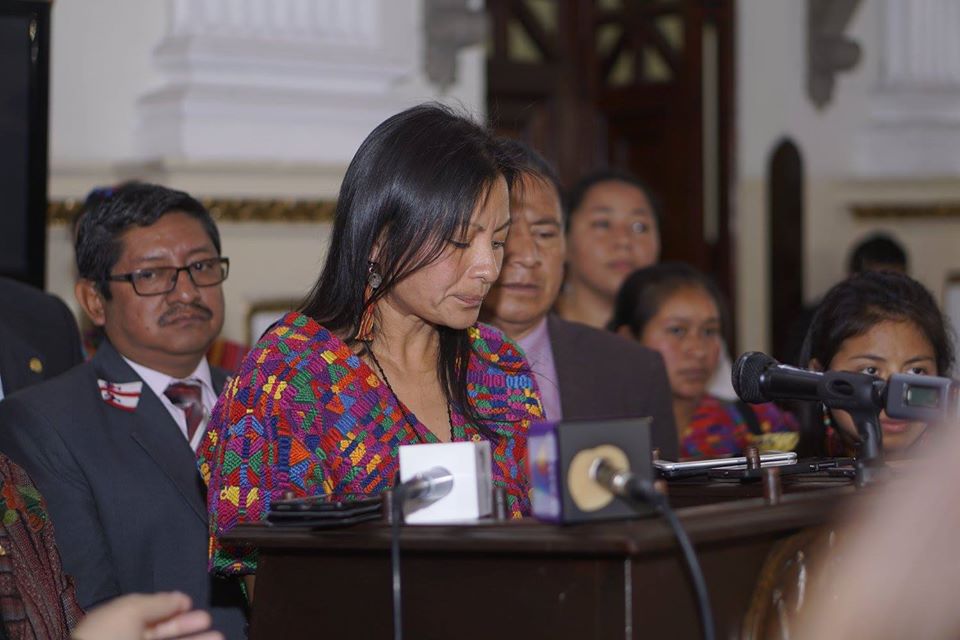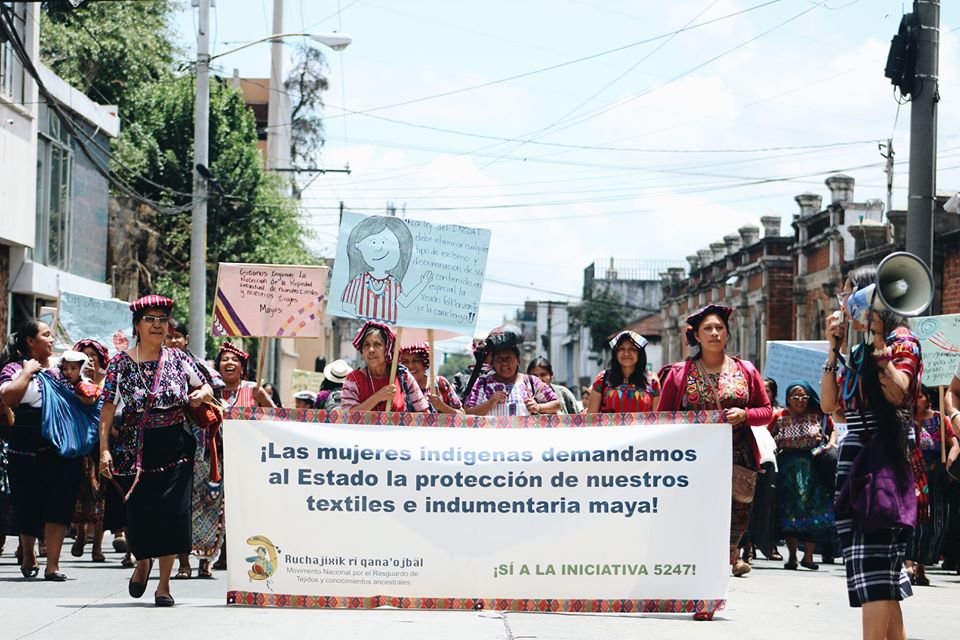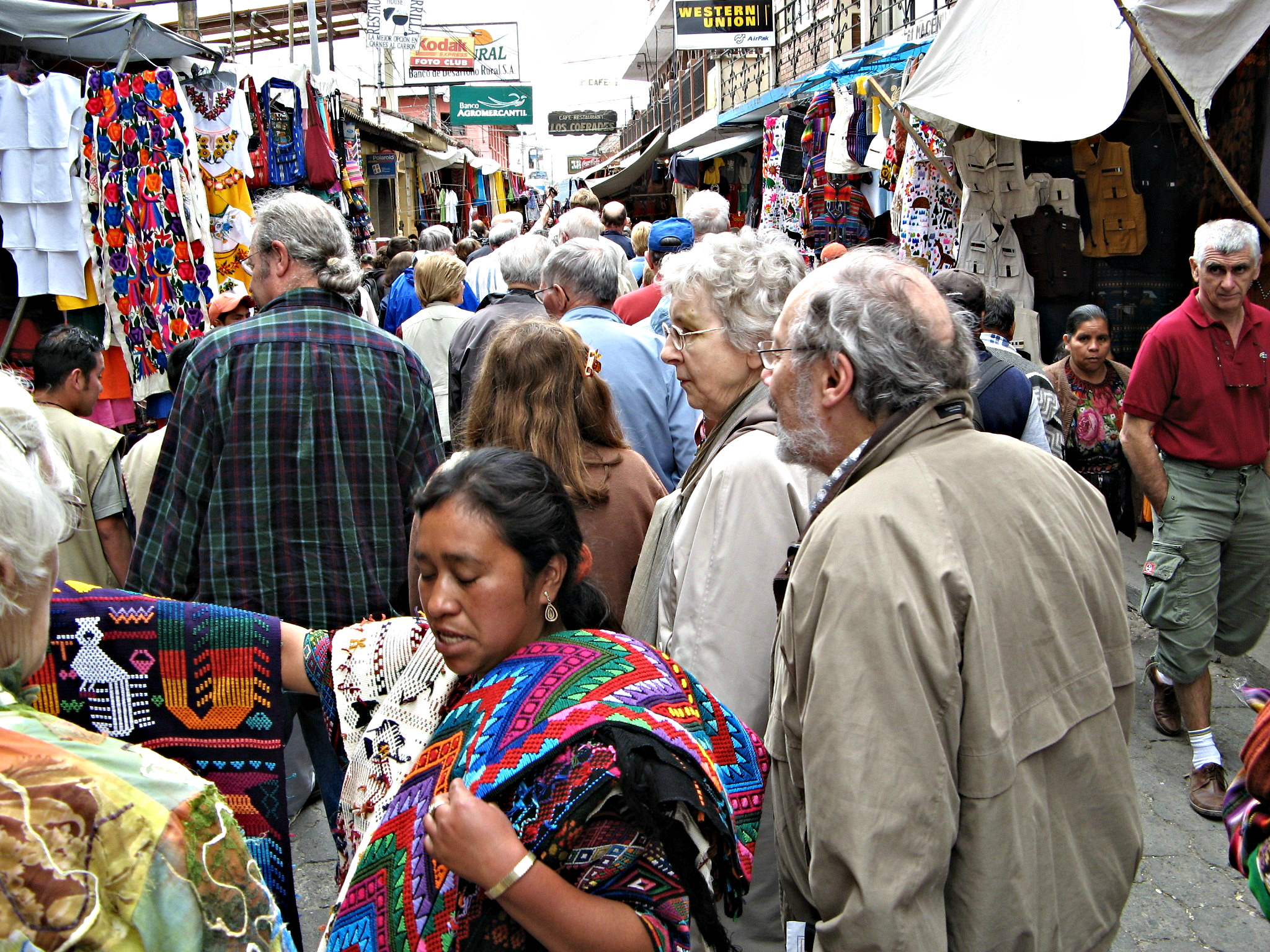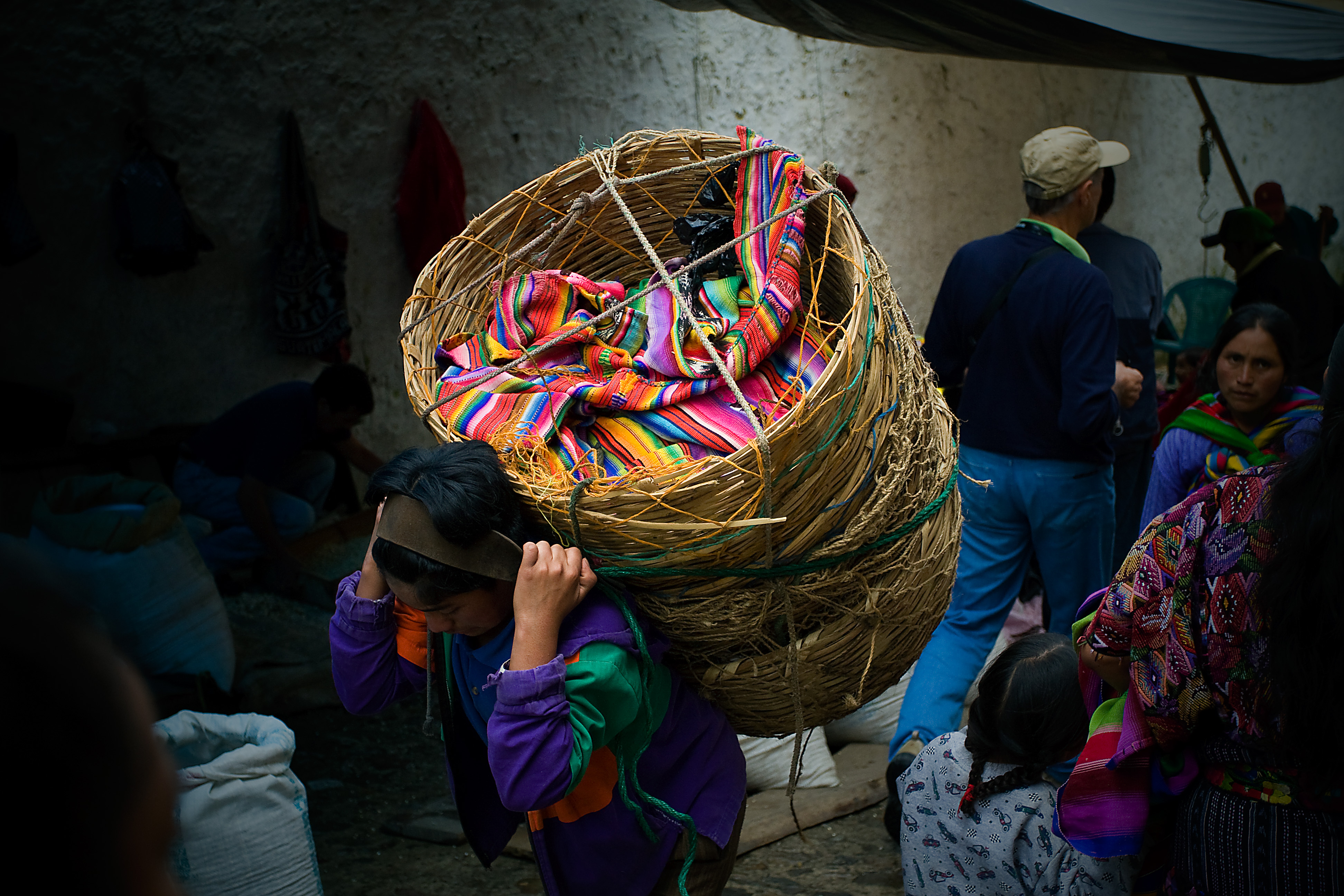15-03-2020
The Mayan weavers of Guatemala: the fight against cultural appropriation of their art
Marta Salvador | Alba SudThe Guatemalan weavers are protagonists of a movement for the revindication of their culture, heritage and art. Women fight against cultural appropriation of their ancestral textiles, representatives of their past, present and future history.

Photography by: San Antonio de Aguas Calientes, Sacatepéquez. Eileeninca, under licence of creative commons.
Guatemala is one of the South-American countries with more indigenous villagers, more concretely, 55%. Despite the centuries of foreign colonization, civil wars and the paramilitary that reduced the native communities of the Guatemalan territory, different indigenous collectives, successors of the Mayan culture, make an important part of the society (Méndez, 2018). The Mayan community of Guatemala keeps living under the shadow of the Guatemalan Civil War, which took place between 1960 and 1996 and massacred 200.000 indigenous. Approximately 83% of the murders during the war were Mayan, victims of human rights violations mainly perpetrated by the Government and the Guatemalan army. Some high-ranking members of the Government during this period have been accused of war crimes, included the former army chief, Efraín Ríos Mont, who was condemned of genocide.
One of the artistic and cultural Mayan traditions which lasts until the present times is the art of weaving. In Guatemala, the called waist loom is practiced, which is an artefact made of wood with two ends. One of them is tied to a tree or any object where the loom is firmly held, while the other end is wrapped around the knitter's waist, who sits on her knees. The Guatemalan waist loom represents a place of memory and construction of a collective identity. In this way, ancestral fabrics are used to store cultural information but, at the same time, Mayan dresses, named hupils, are also the bearers of a history of exclusion and resistance. In addition, the production of Mayan fabrics, together with agriculture, is one of the main pillars of the economy in the communities and an important source of employment for women.
Nowadays in Guatemala, it is mainly women who weave and dress in traditional embroidered dresses at the waist loom, as many of the male population have replaced their original clothing with western clothing, which is why Guatemalan indigenous women are the transmitters of historical and cultural memory. Their artisanal production and their traditional clothing represent resistance against policies of oblivion and an instrument of prevention to this oblivion. From this point of view, memory in Guatemala is interrelated with the gender condition (Méndez, 2018).
The movement of weavers for the recognition of their intellectual property and copyrights
These same women weavers have also associated in different organizations, associations or movements such as the Movimiento Nacional de Tejedoras Mayas which gathers close to 30 organizations in 18 linguistic communities in Guatemala. This group is led by the Asociación Femenina para el Desarrollo de Sacatepéquez (AFEDES) which, from 2014, has initiated a process to demand regulations to protect the creations of the indigenous communities to the Guatemalan State. More concretely, it was in May 2016 when weavers gathered in front of the Constitutional Court to demand the State against the omission of rules to protect the Guatemalan clothing and textile designs. During the following months to this demand, weavers received broad national support, provoking a debate about the copyrights and, finally, on November of the same year, the Weavers Movement presented their bill for the recognition of the collective intellectual property of indigenous people, which was formally presented to Congress the 23rd February 2017.

Angelina Aspuac in the submission of the bill. Source: Movimiento Nacional de Tejedoras.
The initiative proposes to reform five articles of the Copyrights and Related Rights Law, the Industrial Property Law, the Artisanal Protection and Development Law and the Criminal Code with two concrete objectives. Firstly, a recognition of the definition of collective intellectual property is required, a fact that is linked with the right of indigenous people to manage and administrate their heritage. Secondly, indigenous villagers aim to be recognized as intellectual authors, which would mean to receive a percentage of benefits coming from the corporations which profit from the exportation of Mayan fabrics.
At the same time, this change in the law contemplates the collective intellectual property as resistance to territorial usurpation. As Picq (2017) exposes, the extractivism of territories is coupled with an extractivism of indigenous work and their ancestral knowledge and community force. On one hand, exporter companies are extracting the Mayan weavers’ productions, exploiting their knowledge and their labour. On the other hand, the confectioning of industrial huipils produced by machines and not by the weavers is starting to happen. This industrialization announces the loss of wisdom that communities have transmitted from generation to generation. However, one of the prides of weavers is to have empowered from this political process, in which there are no intermediaries neither NGOization. They are the ones who organize, analyse the options, inform about how the government works and project their legal strategy.
Even though the Political Constitution of the Republic of Guatemala stablishes the protection of ethnical groups and constitutes that “the State recognizes, respects and promotes their ways of living, habits, traditions, forms of social organization, the use of indigenous clothing in both men and women, languages and dialects”, the application of laws to protect Mayan people is highly limited. Moreover, nowadays there are no documents in the Minister of Economy with a list of the industrial register of companies related to the production of Mayan designs nor the collective property of indigenous communities. At the same time, no regulation of the industry nor the property of weavers are considered. Moreover, no registration to buy fabrics, huipils designs or Mayan textiles is required to the companies, neither protocols or procedures about these productions.
The cultural appropriation and commodification of indigenous art
This legal gap regarding the right of artisanal weavers has allowed any person or company to transform indigenous designs into commodified elements such as a bag or a pair of shoes. For this reason, the Guatemalan Mayan community reports having suffered the theft and appropriation of their fabrics for years, both by foreign companies and local designers that are part of an indigenous community. Some examples are found in the María’s Bag company, founded by Alida Boer, a designer who has been accused of using indigenous Mayan designs without permission and of selling their products for almost 700 dollars. Other brands are UNIK, Hiptipico, Missoni or Valentino, which have also created fashion designs “inspired” in Guatemalan fabrics.

March in the 4th National Meeting of Guatemalan Weavers. Source: Movimiento Nacional de Tejedoras.
However, the case of Guatemala is not the only one, as in other countries such as Mexico, members of the Tlahuitoltepec community of Oaxaca accused in 2015 the French designer Isabel Maran for the plagiarism of their designs in their collection. Another case reported was that of the Spanish brand Intropia, which sold clothes with prints typical of the Oaxacan huipils, from the indigenous community of San Juan Bautista Tlacotzintepec. Despite the claims, the company did not contact the community and there was no government response. This fact led the indigenous people to wonder what role the Mexican government plays in defending its heritage. Other communities such as those in Chiapas and Hidalgo in Mexico reported that at least eight clothing brands, including some international like Zara or Mango, had been plagiarizing their designs, some of which are over 600 years old, between 2012 and 2017. A more recent example is that suffered by the Amerindian guna people of Panama, who saw plagiarism of their tissues in new Nike shoes and reported their launch to the multinational company, which eventually cancelled it last May 2019.
On the other hand, the prevalence of this type of plagiarism and cultural appropriation took 189 delegates of indigenous communities around the world to gather in Geneva in June 2017. The reason for their meeting was to create a special committee inside the World Intellectual Property Organization (WIPO) to forbid the appropriation of indigenous cultures around the world. However, international means that recognize traditional cultural expressions in WIPO are insufficient to regulate cases as the Guatemalan.
As it was explained before, local weavers in all these countries express that they do not benefit from commercial and international interests for the work of their communities. At the same time, they have to confront the new competition coming from mass production, power looms and a potential creation of a design patent of designs by other people or corporations. The differences between local market of huipils and power looms market highlight specially in price and time of fabrication. While weavers spend three months of work to knit a dress that may cost between 50 and 250 dollars, power looms production is reduced to thirty minutes and the price is around 20 dollars. Other times, Mayan designs are simply printed and added to the fabric, reducing the price for the final clients even more. This unregulated industry and without minimum or maximum prices has taken to the worsening of labour conditions of weavers, normally organized in cooperatives and communities. This is how some companies that sell Mayan-inspired designs have outsourced local weavers, securing a fair wage that later has not been the reality. At the same time, weavers encounter lots of obstacles such as the difficulty of obtaining the required certifications of the Guatemalan government in order to exploit their productions, favouring large producers and no individual weavers or small cooperatives (Walsh, 2018).
At the same time, the Government and the Guatemalan Tourism Institute (INGUAT) constantly use the fabrics and indigenous crafts to promote the tourism activity of the country. In this promotion, the State utilises the image of indigenous women with the huipil, carrying out tasks of their daily life without questioning the poor opportunities that exist for women, naturalizing these actions and lifestyle. For this reason, the commodification of indigenous culture is another of the fights that goes with the weavers’ movement who feel exploited by theses authorities, in a State who, in 2017, received 1.212 million dollars (CNDH, 2019). However, there is no compensation for the income coming from visitors in a country where Mayan people are one of the main tourist attractions. Moreover, they are seen as a “folklorized” culture without been recognized as an authentic Guatemalan culture with, even scenes of tourists dressed in indigenous clothing, which means a mockery for the communities.

Tourists in the Mayan market of Chichicastenango. Source: Ali Eminov, under licence of creative commons.
As Georgina Flores (2020) explains, “the tourist uses of the cultural heritage of indigenous communities are justified through a productivist perspective by which heritage is also an economically exploitable and profitable product and, above all, it is considered that tourism can conserve, safeguard and maintain the cultural heritage of communities." This scholar also notes that tourism can sometimes become a form of colonization that strengthens the dominance relations between the northern and global southern countries. Federico Zúñiga (2014) explains that through the audio-visual discourses of tourism, it attracts new consumers, turning local communities, their identity and their culture into exotic products for sale in the tourism market. The content of such audio-visuals may include, for example, the dramatization of traditional dances and music that are shaped by the hegemonic taste of western society. But the subjectivity of the performer, who traditionally danced or sang, can also be modified to reinforce their own identity. This, at the same time, means that the community dances or sings for the tourist, who is attracted by exoticism and the search of authenticity, and consumes cultural identities without thinking about social and political realities in which the majority of indigenous people live.
Fighting for dignity while combating the oppressions
This is how the struggle for the defence of indigenous peoples’ heritage proves latent racism, both institutional and social, and shows the necessity of a social transformation which does not reify the Mayan art, their culture and their inhabitants, but rather recognize their millennial value, their complexity and their richness as a cultural bond between the past and the present. Moreover, the commodification of the Mayan culture and the textile art places the weavers in front of a triple oppression: racist-colonialist, sexist-patriarchal and social class-capitalist. Indigenous women in Guatemala, as in many other parts of the world, a part of being exploited at work, face high levels of violence and discrimination. It is why in Guatemala there is a huge social pressure to abandon the use of Maya garments, as they are considered old-fashioned. Fewer and fewer women and girls use traditional clothing because these are becoming less appreciated and respected. Nevertheless, when these pieces are sold or used in other contexts, with racial, sexual and high-class privileges, Mayan fabrics acquire a different and much higher value.
For this reason, this fight, which also pretends to promote the use of tapestries in the communities, has the hope that, when patenting the fabrics and designs, Mayan communities would have more autonomy and control over their culture and their heritage. In this way, copyrights would be divided within the community, which would appoint representatives to negotiate with the companies, who wish to use their designs and to administrate the distribution of the funds perceived by the weavers. In such a way, a collective brand could be created, as the case of Thañí, boosted by a group of Wichí women that live in the province of Salta (Argentina). Through empowerment, from 2015 the weavers spread and commercialize their productions throughout the territory and their communities. This is what the Guatemalan struggle aims to achieve, promoting the creation of schools for women and for children, as well as local weavers schools where they could the ancestral techniques and the meanings of the symbols and figures employed, many of which are related to the communal fight for the land and water. In this way, the copyrights would give the communities the opportunity to break the eternal cycle of poverty and to finally recognize the importance and value of the weavers’ labour (Global Voices, 2017).

Weaver walking on the street. Source: Julien Lagarde, under licence of creative commons.
The political participation of women means being able to redefine their roles in the communities and overcome patriarchal and gender stereotypes. Women defy their exclusion from the public sphere when they acquire responsibility for the rights and the future of their communities through organisation and leadership. Moreover, the promotion of schools in the communities is the base for solidarity economy, economic development and political training that works on the aspects of leadership and cultural identity. This is the reason why associations such as AFEDES or Movimiento Nacional de Tejedoras Mayas are indispensable for the fight for the dignity of the weavers. As they themselves affirm, Mayan textile is a complex and significative art for all the indigenous women. These thin fabrics, with ancient figures and symbols, are not woven just to be attractive, but rather to reflect the history of the communities and the Mayan ancestors. This is why cultural appropriation is turned into a phenomenon that needs to be faced to break with commodification, banalisation and touristification that provokes the enrichment of some cultures versus the disappearing of others as it is, in this case, the Mayan culture in Guatemala.
